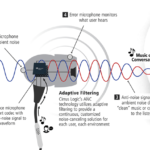Micro-electro-mechanical systems (MEMS) microphones have been steadily increasing their market share, driven by the surge in popularity of voice-controlled electronics with applications like voice-enabled navigation devices and digital home assistants. But what are the different types of MEMS microphone electrical interfaces available and how do you apply them to your application?
A MEMS microphone with an analog output allows for an easy, uncomplicated interface with the host circuit. Driven by an internal amplifier, the microphone will already have reached a sufficient signal level with a relatively low output impedance. Common analog applications that benefit from this straightforward interface are simple loudspeakers or a radio communication system. In addition, this configuration is likely to exhibit lower power consumption than MEMS microphones with a digital output due to the absence of an analog-to-digital converter (ADC).
However, the addition of an ADC has its advantages, particularly when a digital output signal is delivered from a MEMS microphone and applied to digital circuitry, such as a microcontroller or digital signal processor. Output signals from MEMS microphones with a digital interface are also usually encoded with pulse density modulation (PDM) which is ideal where electrical noise immunity and bit error tolerance are concerned.
In this CUI Devices’ blog, CUI’s Principal Applications Engineer, Bruce Rose, compares the two most common MEMS microphone interfaces to help you select the one better suited for your design.




